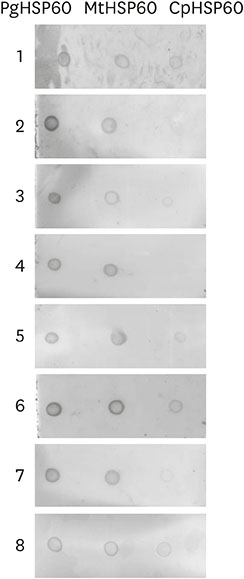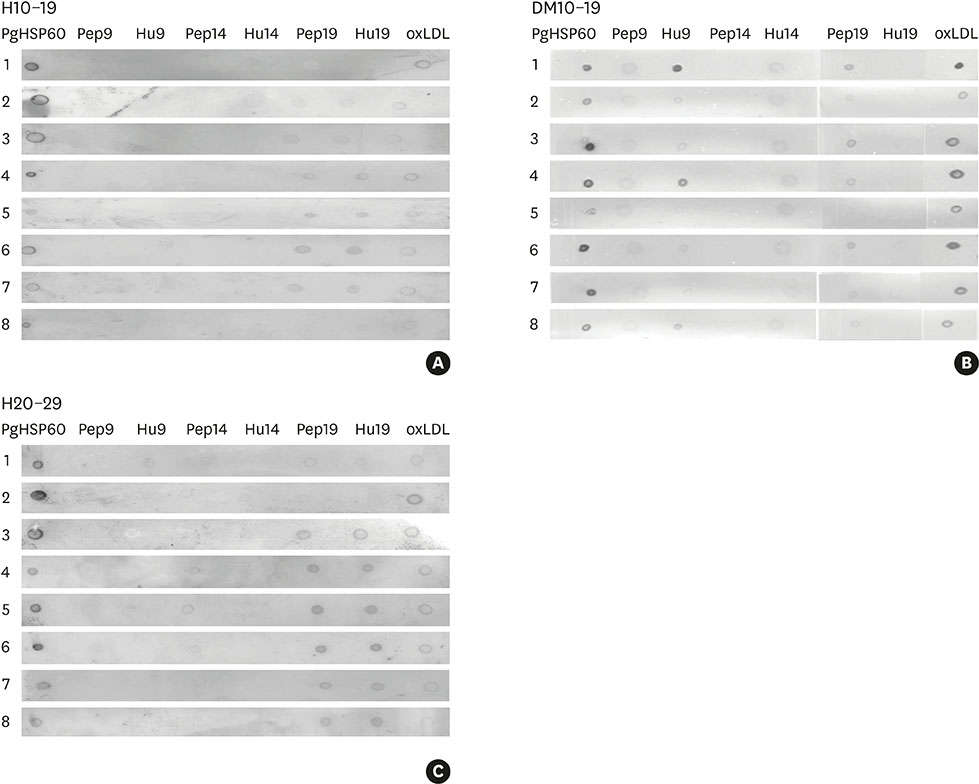J Periodontal Implant Sci.
2017 Jun;47(3):174-181. 10.5051/jpis.2017.47.3.174.
Robust immunoreactivity of teenager sera against peptide 19 from Porphyromonas gingivalis HSP60
- Affiliations
-
- 1Department of Periodontology, Pusan National University School of Dentistry, Yangsan, Korea. rapa@pusan.ac.kr
- 2Biomedical Research Institute, Pusan National University Hospital, Busan, Korea.
- KMID: 2383831
- DOI: http://doi.org/10.5051/jpis.2017.47.3.174
Abstract
- PURPOSE
Epitope spreading is a phenomenon in which distinct subdominant epitopes become major targets of the immune response. Heat shock protein (HSP) 60 from Porphyromonas gingivalis (PgHSP60) and peptide 19 from PgHSP60 (Pep19) are immunodominant epitopes in autoimmune disease patients, including those with periodontitis. It remains unclear whether Pep19 is a dominant epitope in subjects without periodontitis or autoimmune disease. The purpose of this study was to determine the epitope spreading pattern and verify Pep19 as an immunodominant epitope in healthy teenagers using dot immunoblot analysis. The patterns of epitope spreading in age-matched patients with type 1 diabetes mellitus (type 1 DM) and healthy 20- to 29-year old subjects were compared with those of healthy teenagers.
METHODS
Peptide from PgHSP60, Mycobacterium tuberculosis HSP60 (MtHSP60), and Chlamydia pneumoniae HSP60 (CpHSP60) was synthesized for comparative recognition by sera from healthy subjects and patients with autoimmune disease (type 1 DM). Dot immunoblot analysis against a panel of peptides of PgHSP60 and human HSP60 (HuHSP60) was performed to identify epitope spreading, and a densitometric image analysis was conducted.
RESULTS
Of the peptide from PgHSP60, MtHSP60, and CpHSP60, PgHSP60 was the predominant epitope and was most consistently recognized by the serum samples of healthy teenagers. Most sera from healthy subjects and patients with type 1 DM reacted more strongly with PgHSP60 and Pep19 than the other peptides. The relative intensity of antibody reactivity to Pep19 was higher in the type 1 DM group than in the healthy groups.
CONCLUSIONS
Pep19 is an immunodominant epitope, not only in autoimmune disease patients, but also in healthy young subjects, as evidenced by their robust immunoreactivity. This result suggests that the Pep19-specific immune response may be an initiator that triggers autoimmune diseases.
MeSH Terms
-
Adolescent*
Autoimmune Diseases
Autoimmunity
Chlamydophila pneumoniae
Diabetes Mellitus, Type 1
Epitopes
Healthy Volunteers
Heat-Shock Proteins
Humans
Immunodominant Epitopes
Mycobacterium tuberculosis
Peptides
Periodontitis
Porphyromonas gingivalis*
Porphyromonas*
Epitopes
Heat-Shock Proteins
Immunodominant Epitopes
Peptides
Figure
Reference
-
1. Kivity S, Agmon-Levin N, Blank M, Shoenfeld Y. Infections and autoimmunity--friends or foes? Trends Immunol. 2009; 30:409–414.2. Vanderlugt CL, Begolka WS, Neville KL, Katz-Levy Y, Howard LM, Eagar TN, et al. The functional significance of epitope spreading and its regulation by co-stimulatory molecules. Immunol Rev. 1998; 164:63–72.
Article3. Lehmann PV, Forsthuber T, Miller A, Sercarz EE. Spreading of T-cell autoimmunity to cryptic determinants of an autoantigen. Nature. 1992; 358:155–157.
Article4. Vanderlugt CL, Neville KL, Nikcevich KM, Eagar TN, Bluestone JA, Miller SD. Pathologic role and temporal appearance of newly emerging autoepitopes in relapsing experimental autoimmune encephalomyelitis. J Immunol. 2000; 164:670–678.
Article5. van Noort JM, Bajramovic JJ, Plomp AC, van Stipdonk MJ. Mistaken self, a novel model that links microbial infections with myelin-directed autoimmunity in multiple sclerosis. J Neuroimmunol. 2000; 105:46–57.
Article6. Ercolini AM, Miller SD. The role of infections in autoimmune disease. Clin Exp Immunol. 2009; 155:1–15.
Article7. Steinman L. Despite epitope spreading in the pathogenesis of autoimmune disease, highly restricted approaches to immune therapy may still succeed [with a hedge on this bet]. J Autoimmun. 2000; 14:278–282.
Article8. Kurien BT, Scofield RH. Autoimmunity and oxidatively modified autoantigens. Autoimmun Rev. 2008; 7:567–573.
Article9. Vanderlugt CL, Miller SD. Epitope spreading in immune-mediated diseases: implications for immunotherapy. Nat Rev Immunol. 2002; 2:85–95.
Article10. Tabeta K, Yamazaki K, Hotokezaka H, Yoshie H, Hara K. Elevated humoral immune response to heat shock protein 60 (hsp60) family in periodontitis patients. Clin Exp Immunol. 2000; 120:285–293.
Article11. Choi J, Lee SY, Kim K, Choi BK. Identification of immunoreactive epitopes of the Porphyromonas gingivalis heat shock protein in periodontitis and atherosclerosis. J Periodontal Res. 2011; 46:240–245.
Article12. Jeong E, Lee JY, Kim SJ, Choi J. Predominant immunoreactivity of Porphyromonas gingivalis heat shock protein in autoimmune diseases. J Periodontal Res. 2012; 47:811–816.
Article13. Kwon EY, Cha GS, Jeong E, Lee JY, Kim SJ, Surh CD, et al. Pep19 drives epitope spreading in periodontitis and periodontitis-associated autoimmune diseases. J Periodontal Res. 2016; 51:381–394.
Article14. American Diabetes Association. Diagnosis and classification of diabetes mellitus. Diabetes Care. 2012; 35:Suppl 1. S64–S71.15. Joo JY, Cha GS, Chung J, Lee JY, Kim SJ, Choi J. Peptide 19 of Porphyromonas gingivalis heat shock protein is a potent inducer of low-density lipoprotein oxidation. J Periodontol. 2017; 88:e58–e64.16. Yu M, Johnson JM, Tuohy VK. A predictable sequential determinant spreading cascade invariably accompanies progression of experimental autoimmune encephalomyelitis: a basis for peptide-specific therapy after onset of clinical disease. J Exp Med. 1996; 183:1777–1788.
Article17. Kamphuis S, Albani S, Prakken BJ. Heat-shock protein 60 as a tool for novel therapeutic strategies that target the induction of regulatory T cells in human arthritis. Expert Opin Biol Ther. 2006; 6:579–589.
Article18. Sfriso P, Ghirardello A, Botsios C, Tonon M, Zen M, Bassi N, et al. Infections and autoimmunity: the multifaceted relationship. J Leukoc Biol. 2010; 87:385–395.
Article
- Full Text Links
- Actions
-
Cited
- CITED
-
- Close
- Share
- Similar articles
-
- Production and characterization of cross-reactive anti-Porphyromonas gingivalis heat shock protein 60 monoclonal antibody
- T-cell epitope specificity for Porphyromonas gingivalis heat shock protein in periodontitis
- Epitope specificity of Porphyromonas gingivalis heat shock protein for T-cell and/or B-cell in human atherosclerosis
- Reduced alveolar bone loss in rats immunized with Porphyromonas gingivalis heat shock protein
- Environmental factors regulating the expression of Porphyromonas gingivalis heat shock protein



